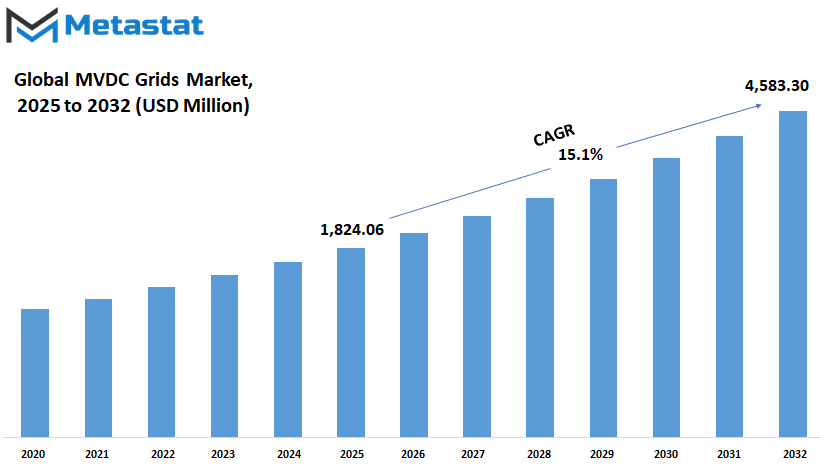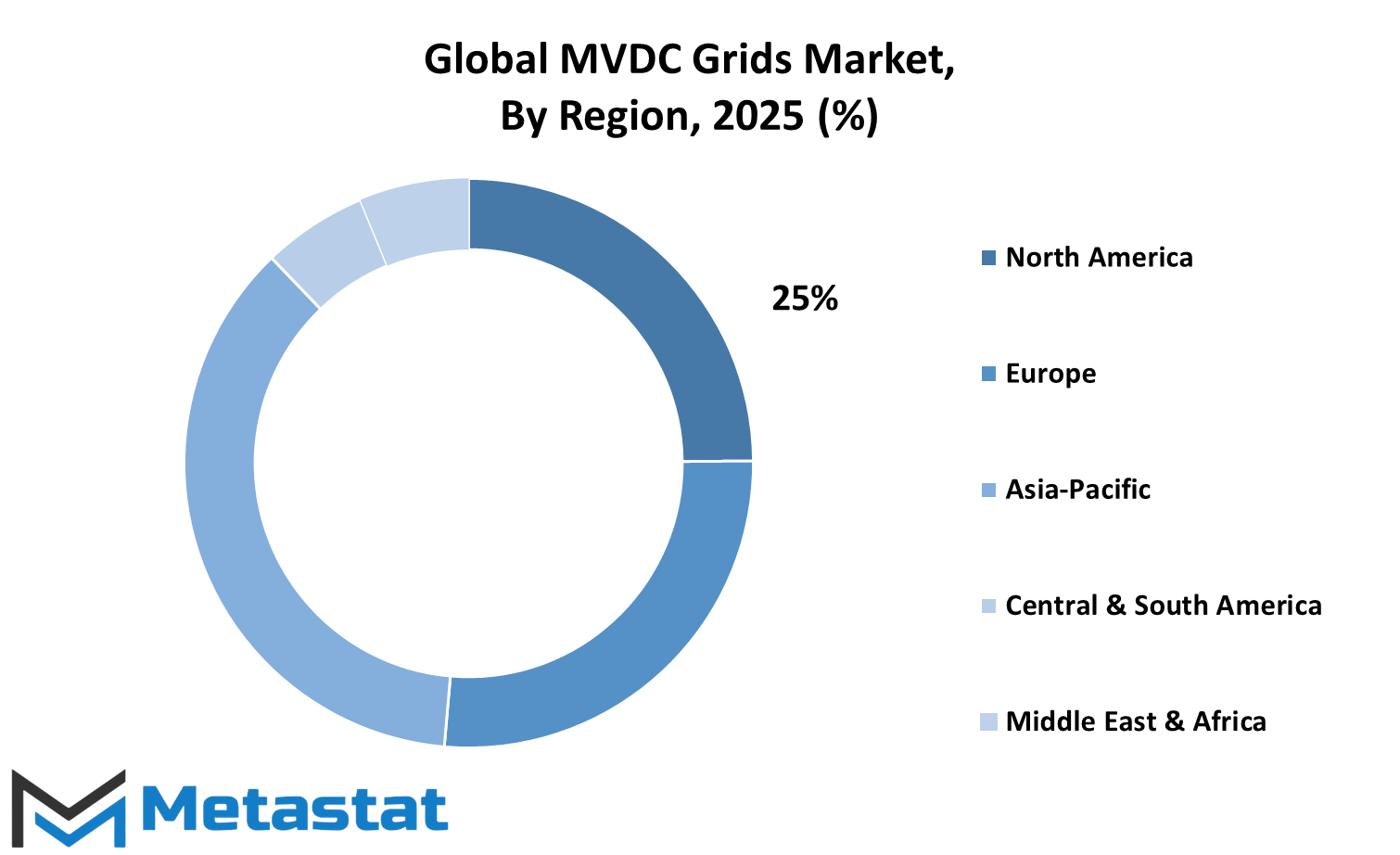MARKET OVERVIEW
The Global MVDC Grids market would pose as an important segment in power system engineering with the shifting patterns of transition toward distributed energy and its infrastructure digitization. Once the barriers are crossed regarding the technology, and the interest of the industry on MVDC grids increases, there will be opportunities in MVDC grid applications to provide a lively solution for modern power challenges through better control, efficiency, and adaptability among all energy landscapes.
The market is a part of Electrical Power Transmission and Distribution Industry, which focuses on medium-voltage direct current systems for modern energy network support in the global MVDC grids market. The scope of the market covers the transition from the existing AC infrastructure to steadier and more efficient DC operational based grids at medium voltages. Unlike the high-voltage DC lines, which are mainly for long-distance transmission, medium-voltage DC systems have the flexibility needed for regional and local integration, especially where we see renewable energy, storage systems, as well as more hybrid power becoming more pronounced.
Medium-voltage direct current (MVDC) provides a newer way to manage and distribute electrical energy in networks that are becoming increasingly decentralized. The market of the Global MVDC Grids is targeting industries that wish to optimize energy flow over shorter distances while reducing losses and maintain voltage stability. They also rank high among considered customers; utilities, industrial zones, offshore platforms, and military applications are worth thousands in savings for MVDC under modernization yet load management and digital monitoring.
An Interesting Coverage of This Market Will Include Local Components Such as Converters, Circuit Breakers, Transformers, and Control Systems, for All-MVDC Applications. The SCAs and Equipment Manufacturers Will Play a Significant Role in Defining Future Grid Topologies through Deployment of Scalable MVDC Platforms. Unlike conventional AC networks, MVDC networks will allow power to be directed with more precision, reduce synchronizing issues, and master better bidirectional flows. All these features convey the importance of MVDC for future smart grids where energy sources and demand patterns are no longer centralized or predictable.
Recent data in power electronics and semiconductor technologies will influence the future of the Global MVDC Grids market. Such reductions in size and increases in efficiency make the benefit of higher power density available for mounting MVDC systems in spaces constrained by consideration of space and thermal performance. This will demonstrate the capability of supporting microgrids and hybrid installations with wind, solar, and storage solutions that further solidifies MVDC in areas of grid resilient and autonomous power.
Over time, legal frameworks and sector standards will evolve gradually to recognize this new market, eventually as flexible and modular architectures spread across power systems. The Global MVDC Grids market will function in a space conducive to innovation but stringent in compliance and interoperability. Utilities and operators will construct arrangements for pilot projects and demonstration platforms before mass adoption to ensure the compatibility of all systems with both new and legacy installations.
Global MVDC Grids market is estimated to reach $4,583.30 Million by 2032; growing at a CAGR of 15.1% from 2025 to 2032.

GROWTH FACTORS
The Global MVDC Grids market include the continuous improvements in power electronics. Modern developed power electronics increasingly make systems more dependable, compact, and cost-competitive. Consequently, this tendency would ease the implementation of MVDC solutions. This modernization of technology would make it more feasible to discuss the establishment of power networks using both AC and DC systems. In the future, there could be more hybrid systems emerging due to upsurging demands for power and increased sources of energy.
Growing demand for efficient power transmission in renewable energy integration. and Advancements in power electronics and grid modernization initiatives. are key driving factors of the market. However, High initial investment costs limiting widespread adoption. and Technical challenges in standardization and interoperability with existing AC grids. might hamper the market growth. Expansion of smart grid infrastructure and hybrid AC/DC power ne Getting ahead now, the Global MVDC Grids markets silently turned up among energy systems worldwide towards cleaner and more efficient solutions.
They need a transmission system that easily handles energy flow in a scenario where wind and solar showing increased sources of renewable energy. Long-distance transmission and loss of energy become critical issues associated with AC grids especially when you have to connect renewable sources located far from populated areas. The answer is MVDC (Medium Voltage Direct Current). It minimizes the loss of energy over a distance and allows better control over the power flow.
One of the major reasons this market is projected to grow in the years to come is because of increased demand for extremely efficient power systems that will handle future renewable energy integration. Countries will have to move an ambitious stride in their targets for carbon reduction and adoption of clean energy with parallel changes in energy transmission methods. MVDC technology is right in place regarding the contribution it will have in that transition. It easily meets the kind of performance and reliability needed for newer energy sources. Throughout much of the world aging grid systems are now being refurbished or completely replaced with modernized ones to serve the contemporary needs. Again, this generally involves a shift to smart grids, digital technologies, and the opening up of MVDC systems to be included in their planning and development process.
However, certain obstacles can lead to sluggish growth in this context. High upfront expenses can serve as a disincentive for both public and private investments, particularly in cases where energy budgets are already under strain. Again, even at that, MVDC systems have to work well with the existing AC grids interphase which is not simple at times. Therefore, institutional barriers across countries and companies concerning technical compatibility and establishment of common standards are hurdles required to put in time to clear.
But still, the Global MVDC Grids measure has a sunny disposition. The moment the backbone infrastructure for smart grids is up and running and hybrid networks become commonplace, this technology could once again emerge as a core component in the power paradigm shift towards providing solutions that are more reliable, flexible, and sustainable.
MARKET SEGMENTATION
By Component
The demand for power transmission over long distances with high reliability and prestige is rising, gradually making way for concern regarding the Global MVDC Grids market. This scene would likely be the future of electricity distribution. Unlike the traditional system, the MVDC (Medium Voltage Direct Current) technology uses power transmission to cover longer distances with fewer losses and better controlled and stable transmission. It has become urgent with the connecting of increasing renewable energy sources to the national grids, which have taken a serious turn for advanced infrastructure requirements. It signals the timing and height of the Global MVDC Grids market by this demand created toward developing different areas fostering this technology.
The component segment is one of the main parts of this market. Among the items are converters and inverters, converting the power from alternating to direct current or vice versa. All of these contribute to load balancing, as well as voltage that needs stabilizing and flexible operation of the network. With increased power demand, converters and inverters would continue to play a greater role. Cables and conductors are also vital components since they transmit the power within various parts of the system. The future enhancements of these materials will probably focus on efficiency and increased power handling without significantly rising heat and energy losses.
Transformers will be used in the MVDC setup to step voltage either up or down according to the demand of the grid; they will maintain system stability, bridging the voltage gap. Circuit breakers and switchgear provide protection and disconnection allowing parts of the networks to be shut down without causing impairment to the entire system. These components will tend to be more intelligent and responsive as grids become complex and wide. The Global MVDC Grids market would feature an increasing digital solution portion in the coming years, focusing on making these systems intelligent and rapid responding to faults or changes.
Just as fast growing is power control systems-the systems for managing energy flows within the grid-supply the demand signals and control the responses to load-serve and protect the system from blackouts-improve performance. Control systems with rapid response along this variable will be critical in the usage of on- and off-shore wind and solar energy. The Global MVDC Grids market will soon have importance in nations transitioning to cleaner and more reliable energy. Every part would accrue investment and shape power management in the future, enabling possibilities for smarter and greener energy solutions.
By Voltage Range
Demand for electricity is being increasingly grown by industries and power systems; Global MVDC Grids Market will see growth because of these. The expected MDVC grids will proved by the power management over long distances by integrating renewables more efficiently into power delivery systems. The modernization of countries with electrical infrastructure and less load on existing systems will pave the way for future common systems which could be found within the entire power distribution landscape-MVDC grids.
Strving towards its objective, it is the type of market that will demand reliable energy systems much needed flexibility to adapt to the coming needs. These grids will thus be developed to cater for transmitting great capacities of power losslessly from the conventional techniques. Besides, as innovation in technology improves, expanding MVDC will not be problematic in various types of site or terrains - from rural flat-lands to developing urban centers. As the demand for electric power continues to climb, so will the industries become inclined to such grids: using MVDC to alleviate pressure on existing systems and making their objectives for clean energy realized.
The Global MVDC Grids market is segmented into three voltage ranges: 1kV -10kV, 10kV -35kV, and above 35kV. These meet different types of demands. The lowest voltages may tend to fit more to smaller communities or localized grids, while higher voltages would fit into larger transmission infrastructures. This complement even more to the growing use of renewable energy since, with the help of higher voltage MVDC grids, electricity transmission from far-away wind or solar farms, away from urban areas, could be made. This means possible incorporation of more clean energy without stressing much on existing AC transmission systems.
The future of the Global MVDC Grids Market seems bright considering the innovations in conversion technology and changes in material that will eventually lower installation and maintenance costs of systems. Governments and companies are finally perceiving the benefits in adopting MVDC as part of more sweeping sustainable energy strategies. Of course, full-scale adoption will take a while, but good signs are coming from the very active research and demonstration and pilot projects. The systems are perceived as not being an option anymore, but rather a critical step toward building smarter, balanced power networks. Indeed, with time, these grids would become cornerstones of the world energy systems.
By Application
With the rising global demand for efficient and stable electricity, MVDC grids will gain in relevance to transmission and utilization. MVDC grids enhance the capability of energy systems to deal with larger and more complex loads while minimizing major losses as an obvious shift towards cleaner energy resources and smarter technology is underway. MVDC offers utmost efficiency with minimum disturbances in delivering power to long distances. While traditional systems are in practice, modern society requirements are increasing their encroachment or outright replacement by MVDC grids.
In the future, it will be quite important for offshore wind farms to depend on the MVDC grids. With their location far off the coast, energy transmission to the land with traditional methods becomes uneconomical at times. The energy losses will be less with expedited transmission; thus, making offshore energy production for a viable and sustainable case. The other area where the market is expected to expand is industrial power distribution. Industrial units and large-scale manufacturing plants need a constant and reliable supply of energy for their operations. The MVDC grid can therefore reduce any downtime arising from energy disturbances and improve the reliability of operations.
Urbanization and smart grid infrastructure expansion will be other future aspects that drive the Global MVDC Grid market. The growing population and digital connectivity of these cities demand a reliable and flexible power source. Urban grids can better control and integrate renewable energy inputs such as solar and wind with MVDC systems, thus relieving older infrastructure and easing the transition to cleaner energy solutions.
The other force that is to affect this market is transportation electrification. The more cars go electric, the more charge stations and energy storage systems must be built that are fast and reliable. MVDC grids can serve these needs by offering economically efficient power delivery systems directed at meeting the charging demand. Eventually, remote and island power systems will gain from this technology. MVDC grids will provide a stable alternative for many of these locations which face consistent power problems, thereby boosting energy independence concerns. Thus, this leaves all of the Global MVDC Grids market prospects very good, even more so, considering the drive for greener, efficient, and smarter energy solutions is everywhere on the global stage.
By End-User
The Global MVDC Grids market is going to be a major determinant of how energy shall be distributed and used in the future. The market is anticipated to take on much greater significance as energy continues to be challenged with greener and more efficient ways of delivery. MVDC assists in managing power losses, enables renewable energy sources to be integrated, and enhances grid stability. A combination of these benefits will be a key factor in deciding the adoption of MVDC systems in other sectors over time.
In the drive for MVDC implementation, representatives from the utility and power generation business stand to benefit most. They need reliable and stable power networks to meet increasing demands and to accommodate new renewable resources such as solar and wind. By providing improved control over the movement of power in the system, MVDC would thus enable real-time balancing of supply and demand; permitting longer-distance transmission with lower losses; that is, transporting power from these far-off sites to centres of population.
MVDC grids will be increasingly sought by the industrial and commercial sectors as enterprises seek to reduce costs and increase energy efficiency. Factories, big office buildings, and data centers are large consumers of electricity, and MVDC systems can thus provide stable and efficient power delivery. This technology can help mitigate wear and tear in their equipment, which results in the added benefit of fewer maintenance needs for such energy-intensive operations.
Another sphere where MVDC is going to prove useful is in transportation. With the rise of electric vehicles, stronger charging networks are required. MVDC is an enabling technology for faster and more reliable charging stations in high-demand locations. In rail and shipping, using MVDC improves energy efficiency and facilitates a shift from older, less efficient systems, thus contributing to lower emissions while increasing performance gains.
Governments and military organizations will likely stimulate growth in the Global MVDC Grids market as well. These groups often work in situations where reliability of power is of utmost importance, and the consequences of outages can be dire. In such scenarios, MVDC would offer backup power, give energy independence, and prop up operations critical in regions that could be urbanized or remote. Increased attention to energy security and sustainability means that government-driven projects will be a helping hand to the investment opportunities to take off with MVDC technology.
From here onwards, the Global MVDC Grid market will steadily grow as more sectors benefit from this technology. Its clean energy support, cost reduction ability, and improvement of grid performance shall earn it a strategic place in the power landscape of tomorrow.
|
Forecast Period |
2025-2032 |
|
Market Size in 2025 |
$1,824.06 million |
|
Market Size by 2032 |
$4,583.30 Million |
|
Growth Rate from 2025 to 2032 |
15.1% |
|
Base Year |
2024 |
|
Regions Covered |
North America, Europe, Asia-Pacific, South America, Middle East & Africa |
REGIONAL ANALYSIS
Globally, the MVDC Grids market is very promising in growth and potential. Such regions where the market of MVDC technology would differ would be more active or prepared. This distinguishes each area from their driving factors, whether government support, industrial demand, or upgrading aging infrastructure, since all regions push slowly for cleaner energy systems or more reliable ones, with some already making further moves toward incorporating MVDC.
North America will invariably join them. The U.S. has invested in grid modernization for decades, and this emphasis on renewable energy will only make the call for MVDC solutions greater. Canada could benefit from such systems because of the immense distances between the point of energy production to consumption. Mexico, which is still developing parts of its energy system, will gradually see increasing interest as it seeks to more stable and less costly power sources. All these countries are working toward improving their electricity networks; MVDC grids will be part of such development.
The MVDC grid transition in Europe will be facilitated by countries like Germany and the UK, which are already known for renewable energy policies. In addition, France and Italy are considering the best practices for more balanced regional power supply and demand. With the varying kinds of climates and energy needs, MVDC systems can smooth out and allow more flexibility in operations. Even in areas considered to be Rest of Europe, small countries are examining their possibilities to upgrade their systems but within the constraints of environmental goals.
Asia-Pacific is another area full of promise. China and India, two of the largest markets in the globe given their need for energy, would benefit from MVDC technology to improve its efficiency in delivering power over long distances. Japan and South Korea, meanwhile, are very industrialized nations that are trying out the latest technologies in making their grids more resilient. Other nations in the region are recognizing the long-term benefits of investing in MVDC grids.
South America will move at a different pace from the Middle East and Africa, but growth is bound to occur. Energy projects for rural and remote areas are benefiting both Brazil and Argentina. Areas of the Middle East and Africa without equalized access to energy and where isolated communities could be integrated into larger systems may benefit from MVDC grids as pragmatic solutions. All these regions are likely to have an impact on shaping the future of the Global MVDC Grids market, as they all shift their energy needs.

COMPETITIVE PLAYERS
The MVDC Grids market globally is slowly emerging as a commodity. The demand for efficient and flexible power systems can be heard from every corner of the world. MVDC technology offers great prospects as countries move toward more sustainable energy systems and focus on the reliability of electricity networks. It assumes additional significance in areas where the integration of renewable wind and solar into existing power infrastructures is taking place. MVDC systems help manage the outputs of these resources, which can be unpredictable, in ways that traditional setups often struggle to do. The transition from conventional, reliable, user-friendly AC systems to DC-based ones like MVDC is not openley observable yet; however, it is becoming much more clear with the investment in reliable and future-ready energy infrastructure.
In a similar vein, the Global MVDC Grids market will see competitions among key market players in the coming times. From the world's largest players, innovation is being taken to the next level, concentrating on systems capable of sustaining complex loads along with improving the efficiency of the grid. Research and development efforts in this scene are carried out by Siemens Energy and ABB Ltd., both aiming to hasten the arrival of smarter, faster, and more responsive systems to market. In this vein, GE and Schneider Electric are entering the fray with global reach and technical acumen. These firms realize that the demand for clean energy is skyrocketing and are working on making MVDC systems more affordable and scalable.
On the music front, Mitsubishi Electric Corporation and the Sécheron Hasler Group are strengthening their positions via collaboration and developments in products to examine how MVDC systems would alleviate local grid challenges, especially where long-distance transmission is critical. The same goes for Prysmian Group, a key player in the cabling solutions responsible for connecting the different parts of these advanced systems. LS ELECTRIC Co., Ltd, NKT A/S, and Fuji Electric Co., Ltd. are pursuing innovation with their own systems to minimize losses and enhance control and protection mechanisms. Rounding out the group, the Toshiba Energy Systems and Solutions Corporation added value with expertise in large-scale application energy solutions in support of the interest in MVDC grids.
As interest in this technology continues to gain momentum, the future of the Global MVDC Grids market will increasingly attract investment, talent, and interests as competition intensifies. The competition would further strengthen and architect a smarter power system for the world, with each company striving to conclusively solve current energy challenges.
MVDC Grids Market Key Segments:
By Component
- Converters & Inverters
- Cables & Conductors
- Transformers
- Circuit Breakers
- Switchgear
- Power Control Systems
By Voltage Range
- 1 kV – 10 kV
- 10 kV – 35 kV
- Above 35 kV
By Application
- Offshore Wind Farms
- Industrial Power Distribution
- Urban & Smart Grid Infrastructure
- Transportation Electrification
- Remote & Island Power Systems
By End-User
- Utilities & Power Generation Companies
- Industrial & Commercial Sector
- Transportation (Rail, Marine, EV Charging Infrastructure)
- Government & Military
Key Global MVDC Grids Industry Players
- Siemens Energy
- ABB Ltd.
- General Electric (GE)
- Schneider Electric SE
- Mitsubishi Electric Corporation
- Sécheron Hasler Group
- Prysmian Group
- LS ELECTRIC Co., Ltd.
- NKT A/S
- Fuji Electric Co., Ltd.
- Toshiba Energy Systems & Solutions Corporation
WHAT REPORT PROVIDES
- Full in-depth analysis of the parent Industry
- Important changes in market and its dynamics
- Segmentation details of the market
- Former, on-going, and projected market analysis in terms of volume and value
- Assessment of niche industry developments
- Market share analysis
- Key strategies of major players
- Emerging segments and regional growth potential








 US: +1 3023308252
US: +1 3023308252






